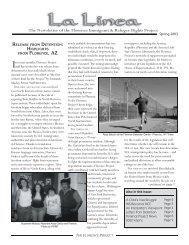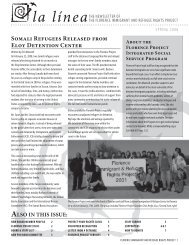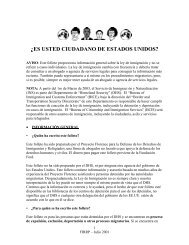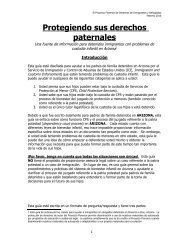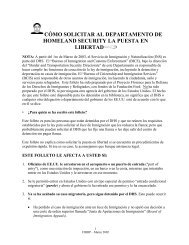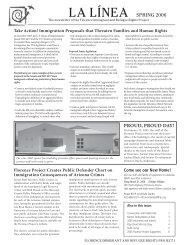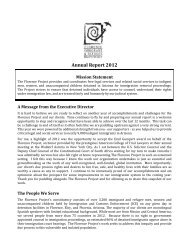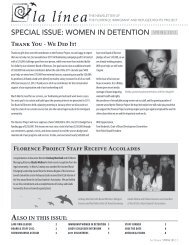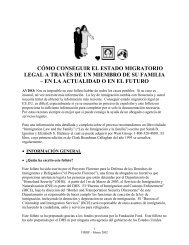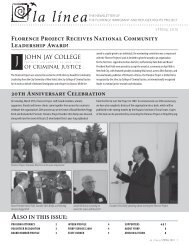quick reference chart and annotations for determining immigration ...
quick reference chart and annotations for determining immigration ...
quick reference chart and annotations for determining immigration ...
Create successful ePaper yourself
Turn your PDF publications into a flip-book with our unique Google optimized e-Paper software.
Immigrant Legal Resource Center, Florence Immigrant <strong>and</strong> Refugee Rights Project,<br />
Maricopa County Public Defender August 2012<br />
convert this into a CMT. Hern<strong>and</strong>ez-Cruz v. Holder, 651 F.3d 1110-1111 (police reports showing that<br />
defendant actually took merch<strong>and</strong>ise cannot deprive defendant of the benefit of his plea bargain).<br />
Aggravated Felony, Bottom-Line: With a sentence imposed of a year or more, this could be held<br />
an AF as either burglary, a crime of violence, or attempted theft. The very best course is to obtain a<br />
sentence imposed of 364 days or less. However, even with a sentence of a year or more imposed, counsel<br />
can guard against AF status by working with the record of conviction.<br />
Explanation: AF as Burglary. Burglary is an aggravated felony with a one year sentence or more<br />
imposed. 8 USC §1101(a)(43)(G). The generic definition of burglary applicable to this aggravated<br />
felony ground is “an unlawful or unprivileged entry into, or remaining in, a building or other structure,<br />
with intent to commit a crime.” Taylor v. United States, 494 U.S. 575 (1990) (emphasis added).<br />
However, the Arizona burglary statutes are broader than the generic definition of burglary <strong>for</strong> at least four<br />
reasons:<br />
1) Unlawful entry. Although Arizona burglary appears to require that the defendant<br />
“enter or remain unlawfully,” the definition of this phrase includes a lawful entry of a<br />
business with an intent to steal merch<strong>and</strong>ise. ARS § 13-1501(2). There<strong>for</strong>e,<br />
<strong>immigration</strong> counsel can argue that a conviction under any of the three burglary<br />
statutes cannot be held an aggravated felony as “burglary” unless the record of<br />
conviction shows an unlawful entry. United States v. Aguila-Montes de Oca, 655 F.3d<br />
915 (9th Cir. 2011) (en banc)<br />
2) “Structure.” The Arizona definition of “structure” includes vending machines <strong>and</strong><br />
vehicles, which do not fit the generic burglary definition. See ARS § 13-1501(12);<br />
U.S. v. Snellenberger, 548 F.3d 699 (9th Cir. 2008) (en banc). Also, the Arizona<br />
definition of “residential structure” includes both movable <strong>and</strong> unmovable structures,<br />
the latter of which does not fit the generic definition of “burglary.” See United States<br />
v. Terrell, 593 F.3d 1084, 1092-93 (9th Cir. 2010) cert. denied, 131 S. Ct. 2094, 179 L.<br />
Ed. 2d 895 (U.S. 2011).<br />
3) “In or on.” While the generic definition of “burglary” requires an entry “into” a<br />
structure, Arizona burglary includes entries both “in <strong>and</strong> on” a structure. Thus, a<br />
person could be convicted of burglary <strong>for</strong> walking on the roof of a structure or <strong>for</strong><br />
sitting on the seat of a motorcycle that was subsequently stolen. State v. Ortiz, No. 2<br />
CA-CR 2008-0372, 2009 WL 1863883, at *3 (Ariz. Ct. App. Jun. 29, 2009)<br />
(affirming § 13-1506(A)(1) conviction <strong>for</strong> defendant who “remained unlawfully on a<br />
motorcycle with the intent to commit theft of that motorcycle”).<br />
4) “Yard.” Since generic burglary requires entry into a structure, an entry into a fenced<br />
residential or commercial yard is not an aggravated felony as burglary. U.S. v Wenner,<br />
351 F.3d 969 (9th Cir. 2003) (Wash. burglary). Note that entry into a residential yard<br />
may be charged as an aggravated felony crime of violence.<br />
Based on these distinctions, counsel can structure pleas in the following ways:<br />
A1. Counsel can: 1) plead to lawful entry of a business or leave the record vague as to whether<br />
the entry was unlawful; 2) plead to entry of a vehicle or an unknown nonresidential structure; 3) plead to<br />
Arizona Criminal Chart with Explanatory Endnote – August 2012<br />
46



